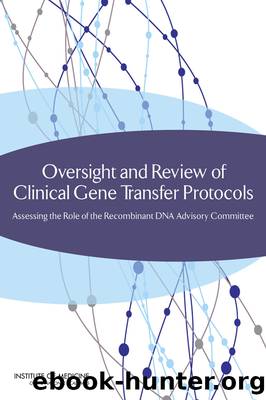Oversight and Review of Clinical Gene Transfer Protocols: Assessing the Role of the Recombinant DNA Advisory Committee by Rebecca N. Koehler

Author:Rebecca N. Koehler
Language: eng
Format: epub
Publisher: The National Academies Press
Published: 2014-01-23T00:00:00+00:00
Food and Drug Administration IND Review
Although NIH provides funding for gene transfer research and has broad authority to oversee research involving rDNA and therefore gene transfer research, the agency ultimately responsible for the regulation and approval of gene transfer technologies is FDA (which refers to these technologies as âgene therapy productsâ). An unapproved drug or, in this case, an unapproved gene therapy product, must undergo FDA review as an IND prior to human use.2 Gene therapy INDs3 are regulated by the Office of Cellular, Tissue, and Gene Therapies (OCTGT) in FDAâs CBER. A key purpose of IND review is to ensure the safety and rights of subjects. The purpose of reviews of phase II and III clinical trials specifically is to help ensure that the quality of the scientific evaluation is adequate to permit determination of drug efficacy and safety. FDA receives approximately 40 to 60 gene transfer INDs each year. FDAâs review follows a regulatory framework in which FDA and the sponsor interact throughout the productâs life-cycle, from pre-IND to post-marketing surveillance. Since 1996, FDA has reviewed 840 gene transfer IND submissions, of which 370 are still active (Takefman, 2013). To date, none of the INDs has progressed to approval for marketing.
CBER regulates cellular transfer products, human gene therapy products, and certain devices related to cell and gene transfer. Within CBER, oversight of gene therapy research and products is the responsibility of the OCTGT. FDA defines gene therapy products as products that âmediat[e] their effects by transcription and/or translation of transferred genetic material and/or by integrating into the host genome ⦠and [that] are administered as nucleic acids, viruses, or genetically engineered microorganismsâ (FDA, 2006, p. 4). The general types of gene therapy products that FDA has reviewed to date are non-viral vectors (plasmids), replication-deficient viral vectors (e.g., adenovirus, adeno-associated virus), replication-competent oncolytic vectors (e.g., measles, reovirus), replication-deficient retro and lentiviral vectors, cytolytic herpes viral vectors, genetically modified microorganisms (e.g., Listeria, Salmonella, E. coli), and ex vivo genetically modified cells (FDA, 2013a). According to a statement by Jay Siegel to the U.S. Senate (U.S. Congress, 2000), CBER uses both the Federal Food, Drug and Cosmetic Act of 19384 and the Public Health Service Act of 19445 as enabling statutes for oversight. FDA regulates âall products that mediate [â¦] genetic material by integration into the host genome, and that are administered as nucleic acids, viruses, or genetically engineered microorganismsâ (FDA, 2006, p. 4). FDA also maintains a federal advisory committee, the Cellular, Tissue and Gene Therapies Advisory Committee, which reviews and evaluates available data related to the safety, effectiveness, and appropriate use of human cells, human tissues, gene transfer therapies, and xenotransplantation products that are intended for transplantation, implantation, infusion, and transfer in the prevention and treatment of a broad spectrum of human diseases and in the reconstruction, repair, or replacement of tissues for various conditions (Statement of policy for regulating biotechnology products, 1986).
The FDA approval process for new biologic drugs involves an investigatorâs obtaining permission from the agency to commence human subjects research by filing an IND application.
Download
This site does not store any files on its server. We only index and link to content provided by other sites. Please contact the content providers to delete copyright contents if any and email us, we'll remove relevant links or contents immediately.
Introduction to Social Work Practice : A Practical Workbook by Herschel Knapp(284)
Selective Oxidation Catalysts Obtained by the Immobilization of Iron (III) Porphyrins on Layered Hydroxide Salts by Fernando Wypych Shirley Nakagaki & Guilherme Sippel Machado(276)
How Data Happened by Unknown(267)
Global Health Governance and Commercialisation of Public Health in India by Anuj Kapilashrami Rama V. Baru(220)
Unmasked by Emily Mendenhall(181)
Curing Cancerphobia by David Ropeik(173)
The Pandemic Divide by Gwendolyn L. Wright Lucas Hubbard and William A. Darity Jr(159)
Feminist Global Health Security by Clare Wenham(148)
Restoring Quality Health Care by Scott W. Atlas(147)
FALSE PANDEMICS: ARGUMENTS AGAINST THE RULE OF FEAR by Wolfgang Wodarg(147)
Transforming Health Care Scheduling and Access: Getting to Now by Gary Kaplan(142)
The Making of a Pandemic: Social, Political, and Psychological Perspectives on Covid-19 by John Ehrenreich(140)
Oversight and Review of Clinical Gene Transfer Protocols: Assessing the Role of the Recombinant DNA Advisory Committee by Rebecca N. Koehler(140)
Pandemic India by Arnold David;(137)
The Metropolitan Academic Medical Center by David E. Rogers Eli Ginzberg(128)
Insane Society: A Sociology of Mental Health by Peter Morrall(128)
Risk Communication and Infectious Diseases in an Age of Digital Media by Anat Gesser-Edelsburg Yaffa Shir-Raz(126)
Psychosocial Interventions for Mental and Substance Use Disorders: A Framework for Establishing Evidence-Based Standards by Mary Jane England(126)
Into Africa, Out of Academia by Kwan Kew Lai(125)
